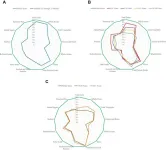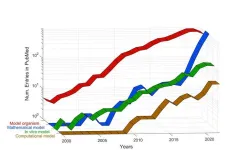(Press-News.org) Philadelphia, September 26, 2023 – In four articles in the Journal of Nutrition and Dietetics, published by Elsevier, leading nutrition experts describe and evaluate the latest versions of the Healthy Eating Index (HEI), issued to correspond to the 2020-2025 Dietary Guidelines for Americans (DGA). For the first time, there are two new HEIs, one for children and adults 2 years and older, and one for young children aged 12 through 23 months.
The Call to Action of the ninth edition of the Dietary Guidelines for Americans is “Make Every Bite Count.” These guidelines form the basis of nutrition policy for the US Government and the foundation of all federal nutrition guidance. Developed to measure alignment with the evidence-based DGA, the HEI is a tool designed to measure diet quality—that is, how closely an eating pattern or mix of foods matches the recommendations in the DGA.
Four articles were written by the Healthy Eating Index Team, through a collaboration between the HHS, National Cancer Institute, and the USDA Food and Nutrition Service.
Jill Reedy, PhD, MPH, RDN, Chief, Risk Factor Assessment Branch, National Cancer Institute, explained: “For the first time, the current DGA (2020-2025) includes a USDA Dietary Pattern for toddlers aged 12 through 23 months. The HEI has a long and robust history of evolving to align with the state of the science. The development of the HEI-Toddlers-2020 is a clear example of this and answers the call by the 2020 Dietary Guidelines Advisory Committee to ‘develop a dietary pattern scoring system, such as the Healthy Eating Index (HEI), for infants and children from birth to 24 months, considering findings from this report and future dietary guidance.’”
Reflecting the current DGA, the HEI articles cover the two separate indices: the HEI-2020 and the new HEI-Toddlers-2020. In addition to an introductory editorial, they include one article that highlights the HEI-2020 that was updated for children and adults (i.e., two years and older); two articles on the new HEI-Toddlers-2020 that was developed and evaluated for toddlers 12 through 23 months; and an overarching article that discusses the continuity, considerations, and future directions for diet quality throughout the lifespan. They contribute to the growing literature on dietary patterns, toddler nutrition, and the healthy eating trajectory.
Both the HEI-Toddlers-2020 and the HEI-2020 have 13 components, each of which reflects an important aspect of diet quality. Nine components focus on adequacy (foods we should eat enough of to get the nutrients we need and for overall good health), and four components focus on moderation (dietary components that should be limited or consumed in small amounts). Calculations using the HEI-Toddlers-2020, like the HEI-2020, result in a total score and a set of individual component scores that reveal a dietary pattern.
HEI-Toddlers-2020 and HEI-2020 radar plots including total scores for each age group are shown in the figure below. Total HEI scores across the lifespan are suboptimal with the highest scores being for young children ages 12 through 23 months (HEI-Toddlers-2020 Total Score 63.4) and adults 60 years and older (HEI-2020 Total Score 59.5).
The HEI-Toddlers-2020, like HEI-2020, has 13 components reflecting all constituents of dietary intake, except for human milk or infant formula. Healthy dietary patterns for toddlers have unique considerations reflected in the scoring standards for Added Sugars and Saturated Fats, notably:
A recommendation to avoid added sugars (the guidance for ages 2 and older recommends limiting added sugars to less than 10% of calories per day)
No recommendation to limit saturated fats to less than 10% of energy intake (the guidance for ages 2 and older recommends limiting saturated fats to less than 10% of energy intake)
Kirsten A. Herrick, PhD, MSc, Program Director, National Cancer Institute, and lead author of a contribution on the future directions of the HEI commented: “The scientific evidence base may continue to evolve and lead to further refinement for tailored recommendations within the birth to 24 months age group, across the lifespan, and to other potential age groupings based on developmental milestones and other concepts about health over time.”
TusaRebecca Pannucci, PhD, MPH, RDN, Branch Chief, USDA Food and Nutrition Service, lead author of a contribution on the development of the HEI-Toddlers-2020 states: “The 2020-2025 edition of the DGA was the first to include comprehensive recommendations for dietary patterns in the second year of life and was the key driver in informing the creation of the HEI-Toddlers-2020. We recognize, as the DGA emphasize, ‘every bite counts,’ and every shift toward a healthy dietary pattern should be acknowledged.”
Marissa M. Shams-White, PhD, MSTOM, MS, MPH, Program Director, National Cancer Institute, lead author of a contribution on the review and update process for HEI 2020-2025, added: “The HEI is used widely in different types of research, particularly as the concept of dietary patterns has grown and continues to evolve. There is continued encouragement for research efforts to add to the scientific evidence base on dietary patterns and help address further methodological questions, including examining needs specific to each life stage and considerations for bridging across them."
The DGA was first published in 1980 and is updated every five years, leading to changes in emphasis and quantification. The DGA provides advice to consumers on what to eat and drink to meet nutrient needs, promote health, and prevent disease. The Dietary Guidelines Advisory Committee drafts a report about the guidelines for a professional audience, including policymakers, healthcare providers, nutrition educators, and federal nutrition program operators. A new HEI is issued to correspond to each new edition of the guidelines and to reflect these changes.
END
Latest version of the Healthy Eating Index covers toddler diet quality
Leading nutrition experts critically review the Healthy Eating Index-2020 and introduce the tandem index for toddlers aged 12 through 23 months in the Journal of the Academy of Nutrition and Dietetics
2023-09-26
ELSE PRESS RELEASES FROM THIS DATE:
U of M Medical School research team studies homicides of health professionals
2023-09-26
MINNEAPOLIS/ST. PAUL (09/26/2023) — Published in the Journal of Clinical Psychology, University of Minnesota Medical School researchers examined homicide rates of health professionals in the United States to inform prevention interventions and strategies.
The research team used the Centers for Disease Control and Prevention’s National Violent Death Reporting System (NVDRS) to collect data on the number of homicides among ten types of health professionals, including doctors, psychologists, nurses, social workers and pharmacists.
The study found rates of homicides ...
UH researcher on team developing sense-and-respond cancer implant technology
2023-09-26
The Advanced Research Projects Agency for Health (ARPA-H) has awarded $45 million to rapidly develop sense-and-respond implant technology that could slash U.S. cancer-related deaths by more than 50%.
The award to a team of researchers from seven states, led by Rice University, will fast-track development and testing of a first-of-its-kind approach to cancer treatment that aims to dramatically improve immunotherapy outcomes for patients with ovarian, pancreatic and other difficult-to-treat cancers.
Weiyi Peng, assistant professor ...
U of M Medical School receives $16 million to uncover the 'wiring diagram' of the brain
2023-09-26
MINNEAPOLIS/ST. PAUL (09/26/2023) — The University of Minnesota Medical School received a $16 million grant from the National Institutes of Health (NIH) Brain Research Through Advancing Innovative Neurotechnologies® (BRAIN) Initiative to support the groundbreaking project of unraveling the mysteries of the brain's ‘wiring diagram.’ Using cutting-edge techniques, this research aims to discover how the brain's neurons are connected and communicate with each other.
The project aims to better understand how complex neural ...
Arctic sea ice 6th lowest on record; Antarctic sees record low growth
2023-09-26
Arctic sea ice likely reached its annual minimum extent on Sept. 19, 2023, making it the sixth-lowest year in the satellite record, according to researchers at NASA and the National Snow and Ice Data Center (NSIDC). Meanwhile, Antarctic sea ice reached its lowest maximum extent on record on Sept. 10 at a time when the ice cover should have been growing at a much faster pace during the darkest and coldest months.
Scientists track the seasonal and annual fluctuations because sea ice shapes Earth’s polar ecosystems and plays a significant role in global climate. Researchers at NSIDC ...
Van Andel Institute appoints new Graduate School dean and chief academic officer
2023-09-26
GRAND RAPIDS, Mich. (Sept. 26, 2023) — Van Andel Institute has appointed Eric Swindell, Ph.D., as dean and chief academic officer of Van Andel Institute Graduate School, effective Dec. 4, 2023.
Swindell joins the Institute after a distinguished 25-year career in scientific research, with the past several years dedicated to leadership positions in biomedical graduate education. He brings a proven track record as a dynamic, energetic and motivational team builder who possesses a deep understanding of science graduate education and a robust commitment to collaboration and inclusiveness.
“I am excited to join Van Andel Institute and honored to ...
Black bisexual women in rural areas are at highest risk for suicidal behaviors
2023-09-26
HERSHEY, Pa. — Non-Hispanic and Hispanic Black bisexual women who live in rural areas have the highest prevalence of experiencing suicidal thoughts and behaviors, according to a Penn State-led study. The researchers said this “first-of-its-kind study,” published in JAMA Psychiatry, revealed how various demographic factors intersect to affect a person’s risk of having suicidal thoughts and behaviors.
An estimated 12 million adults in the United States think about suicide every year, with nearly two million ...
New material captures coronavirus particles and could transform face mask efficiency
2023-09-26
A research team at the University of Liverpool has developed a new material that captures coronavirus particles and could transform the efficiency of face masks and other filter equipment to stop the spread of COVID-19 and other viruses.
In a paper published in the journal Nature Communications, the team showed that the new material used in a conventional face mask was approximately 93% more efficient at capturing proteins, including coronavirus proteins, with little impact on breathability.
The Liverpool scientists behind the new material are Professor Peter Myers, a research leader in chromatography, and Dr Simon Maher, a mass spectrometry expert.
They had ...
Optimizing treatment for acute spinal cord injury
2023-09-26
New Rochelle, NY, September 26, 2023—A special focus issue of the peer-reviewed Journal of Neurotrauma highlights the latest findings of the North American Clinical Trials Network (NACTN), aimed at improving outcomes for individuals with acute spinal cord injury (SCI). Click here to read the issue now.
Led by Guest Editor Michael Fehlings, MD, PhD, from Toronto Western Hospital, the focus issue includes an article on the history and accomplishments of the NACTN, which is a consortium of translational clinical research centers with the overarching aim to translate scientific discoveries in the realm of SCI neuroprotection and neuroregeneration while ...
Determining the meaning of a ‘model’
2023-09-26
The term model is employed quite widely in science and technology.
Researchers in disciplines such as biology, computing, engineering and mathematics each have their own understanding and meaning of what a model is meant to be.
In a timely paper published in the journal Cancers, City, University of London Biomedical Imaging academic, Dr Constantino Carlos Reyes Aldasoro, reviews the use of the word model as it relates to cancer research and the specific area of the microenvironment surrounding a cancer tumour.
He then groups different definitions ...
Decreasing biodiversity may promote spread of viruses
2023-09-26
How are environmental changes, loss of biodiversity, and the spread of pathogens connected? The answer is a puzzle. Scientists from Charité – Universitätsmedizin Berlin in cooperation with the Leibniz Institute for Zoo and Wildlife Research (Leibniz-IZW) have now described one piece of that puzzle in the journal “eLife”, showing that the destruction of tropical rainforests harms the diversity of mosquito species. At the same time, more resilient species of mosquitoes become more prevalent – which also means the viruses they carry are more abundant. If there are many individuals of a given ...
LAST 30 PRESS RELEASES:
Sleeping in on weekends may help boost teens’ mental health
Study: Teens use cellphones for an hour a day at school
After more than two years of war, Palestinian children are hungry, denied education and “like the living dead”
The untold story of life with Prader-Willi syndrome - according to the siblings who live it
How the parasite that ‘gave up sex’ found more hosts – and why its victory won’t last
When is it time to jump? The boiling frog problem of AI use in physics education
Twitter data reveals partisan divide in understanding why pollen season's getting worse
AI is quick but risky for updating old software
Revolutionizing biosecurity: new multi-omics framework to transform invasive species management
From ancient herb to modern medicine: new review unveils the multi-targeted healing potential of Borago officinalis
Building a global scientific community: Biological Diversity Journal announces dual recruitment of Editorial Board and Youth Editorial Board members
Microbes that break down antibiotics help protect ecosystems under drug pollution
Smart biochar that remembers pollutants offers a new way to clean water and recycle biomass
Rice genes matter more than domestication in shaping plant microbiomes
Ticking time bomb: Some farmers report as many as 70 tick encounters over a 6-month period
Turning garden and crop waste into plastics
Scientists discover ‘platypus galaxies’ in the early universe
Seeing thyroid cancer in a new light: when AI meets label-free imaging in the operating room
Neutrophil-to-lymphocyte ratio may aid risk stratification in depressive disorder
2026 Seismological Society of America Annual Meeting
AI-powered ECG analysis offers promising path for early detection of chronic obstructive pulmonary disease, says Mount Sinai researchers
GIMM uncovers flaws in lab-grown heart cells and paves the way for improved treatments
Cracking the evolutionary code of sleep
Medications could help the aging brain cope with surgery, memory impairment
Back pain linked to worse sleep years later in men over 65, according to study
CDC urges ‘shared decision-making’ on some childhood vaccines; many unclear about what that means
New research finds that an ‘equal treatment’ approach to economic opportunity advertising can backfire
Researchers create shape-shifting, self-navigating microparticles
Science army mobilizes to map US soil microbiome
Researchers develop new tools to turn grain crops into biosensors
[Press-News.org] Latest version of the Healthy Eating Index covers toddler diet qualityLeading nutrition experts critically review the Healthy Eating Index-2020 and introduce the tandem index for toddlers aged 12 through 23 months in the Journal of the Academy of Nutrition and Dietetics







